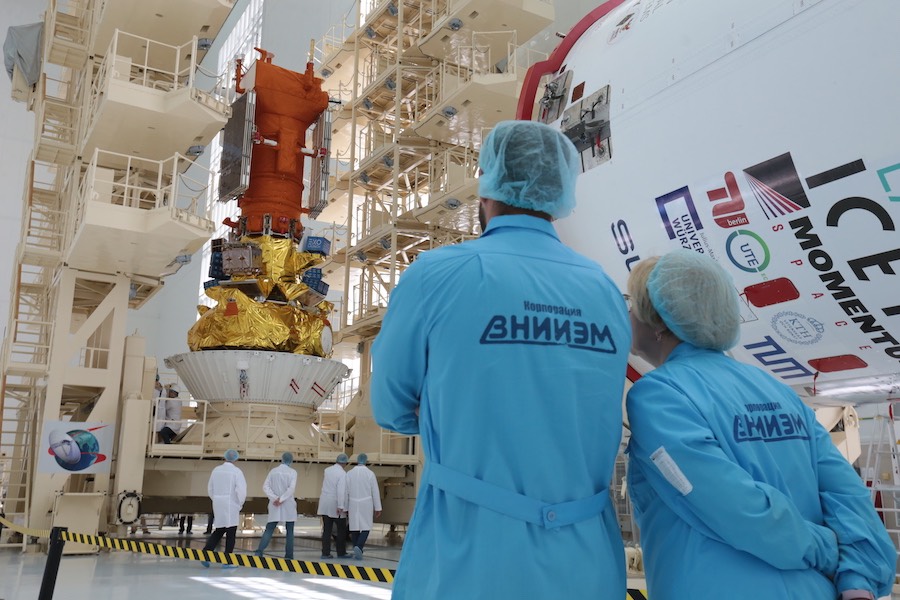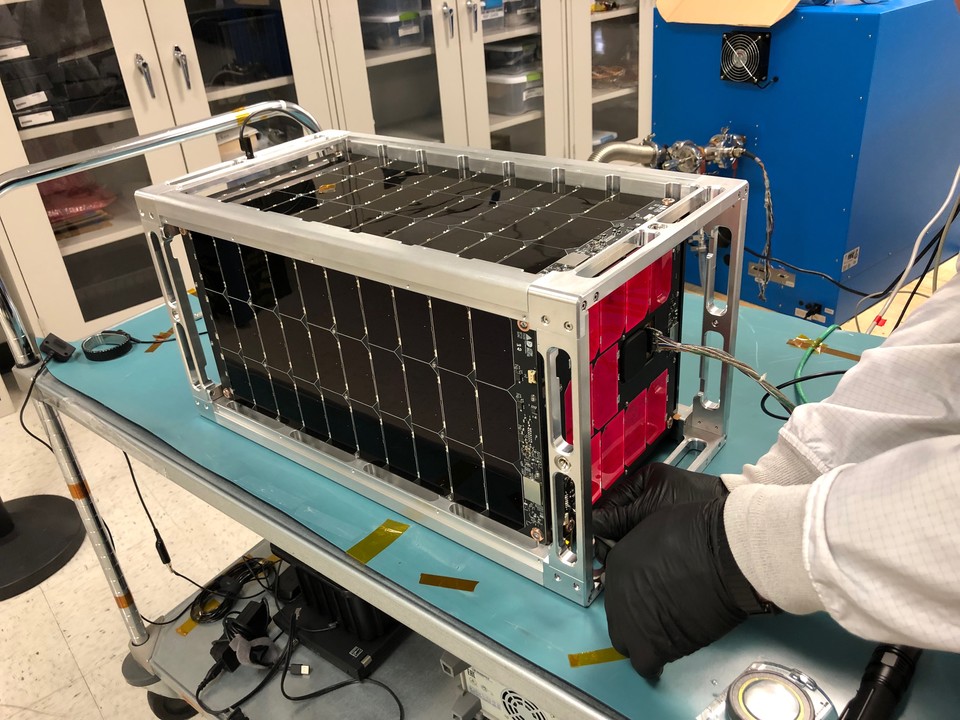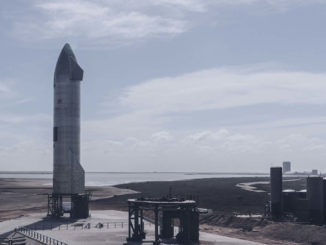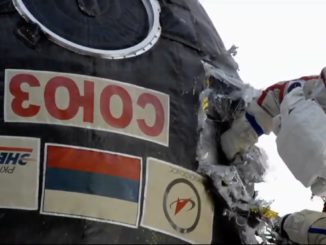
A Soyuz rocket is scheduled for liftoff Friday from the Vostochny Cosmodrome, Russia’s newest launch site, with 33 satellites from 12 countries on-board to collect weather data and test new space technology.
Liftoff of the Soyuz rocket from the Vostochny Cosmodrome, located in Amur Oblast in Russia’s Far East, is set for 0541:46 GMT (1:41:46 a.m. EDT) Friday, or 2:41 p.m. local time at the launch base near Russia’s border with China.
The biggest of the spacecraft awaiting launch Friday is Russia’s Meteor M2-2 weather satellite, a polar-orbiting observatory designed to provide Russian meteorologists with information about cloud and ice cover, atmospheric humidity and temperature, and the ozone layer.
The weather data is useful in formulating medium-range forecasts.
The Soyuz-2.1b rocket and its Fregat upper will deliver 32 smaller payloads to orbit Friday for owners in Russia, Germany, France, the United States, the United Kingdom, Israel, Sweden, Finland, Thailand, Ecuador, Estonia and the Czech Republic.
The Meteor M2-2 satellite, the mission’s prime payload, is owned by the Russian government. Glavkosmos and its subsidiary GK Launch Services — state-owned companies responsible for marketing Russian space products and services internationally — arranged the launch of 29 of the secondary payloads on Friday’s mission.
The German launches services provider Exolaunch brokered a ride for 28 of the small satellites with Glavkosmos.
A video below shows the 33 satellites mounted on their Fregat upper stage, which will ignite multiple times on Friday’s mission to deploy the payloads into three distinct orbits, then fire again to steer back into Earth’s atmosphere for a destructive re-entry to avoid creating additional space junk.
After encapsulation last week inside the Soyuz nose shroud, which will protect the satellites during the initial phase of launch, the payload compartment was attached to the rocket’s third stage, then connected to the rest of the launcher inside a cavernous hangar at the Vostochny Cosmodrome.
The Soyuz launcher rolled out of its assembly hangar Tuesday and rode a rail car to the launch pad at the Vostochny Cosmodrome, where the rocket was lifted vertical over a flame trench carved from bedrock and suspended with four retractable hold-down arms.
A mobile gantry then rolled into position around the Soyuz booster to allow ground crews to complete final preflight checkouts and remove “red tag” covers and other support hardware from the rocket that are not intended for flight.
The Russian State Commission, which oversees launch preps, will give approval hours before launch to begin loading kerosene and liquid oxygen propellants into the three-stage rocket.
The Soyuz-2.1b booster is the latest model of Russia’s venerable Soyuz launcher family, featuring a digital guidance computer and an uprated third stage powered by an RD-0124 engine.
Friday’s mission will be the fifth launch from Vostochny since the Soyuz launch pad became operational in 2016. Russia built the new spaceport to eventually replace the Baikonur Cosmodrome in Kazakhstan, and officials plan to eventually transfer crew launches to Vostochny and are building a new launch pad there for the Russian Angara heavy-lift rocket.
But the site is currently only equipped for satellite launches using Soyuz rockets.
The video below shows ground crews at Vostochny attaching the Soyuz rocket’s payload compartment and third stage to the rest of the booster.
The Soyuz-2.1b rocket will roar away from Vostochny with some 930,000 pounds of thrust from its kerosene-fueled core stage and four boosters, heading north to align with a trajectory that flies over the poles.
Two minutes after liftoff, the rocket’s four boosters will shut down and jettison to fall into the heavily-forested wilderness north of Vostochny, followed by separation of the Soyuz payload fairing and shutdown of the core stage nearly five minutes into the mission.
The third stage’s RD-0124 engine will fire for more than four-and-a-half minutes before running out of fuel and separating from the Fregat upper stage, which will begin a sequence of maneuvers to first reach a preliminary parking orbit, then deploy the mission’s 33 payloads into three distinct orbits hundreds of miles in altitude.
The 6,393-pound (2,900-kilogram) Meteor M2-2 weather satellite will be the first spacecraft to separate from the Fregat upper stage at an altitude close to the observatory’s final operating orbit 513 miles (826 kilometers) above Earth.
The satellite hosts four meteorological instruments: two multi-channel scanners and cameras to obtain infrared and visible images of clouds and ice cover, a microwave radiometer to measure temperature and humidity in the atmosphere, and an infrared spectrometer to monitor the ozone layer.
Built by VNIIEM, a Moscow-based aerospace contractor, the Meteor M2-2 satellite also carries a search-and-rescue radio transponder and a payload to relay data from remote weather stations and offshore buoys to Russian forecasters.
The launch of the Meteor M2-2 spacecraft comes a year-and-a-half after the last satellite in the Russian Meteor series, designated Meteor M2-1, was lost due to a programming error in the Soyuz rocket’s Fregat upper stage that prevented the mission from reaching orbit following a liftoff from Vostochny.
Several of the CubeSat secondary payloads on Friday’s launch are also replacements for the satellites lost in the 2017 launch failure.
The video below shows rollout of the Soyuz rocket to its launch Tuesday at the Vostochny Cosmodrome.
After injecting the Meteor M2-2 weather satellite into orbit, the Fregat upper stage will begin lowered its altitude to release the other 32 payloads in sun-synchronous orbits 360 miles (580 kilometers) and 329 miles (530 kilometers) above Earth, according to Exolaunch, the German launch services provider.
The secondary payloads include CubeSats, microsatellites and a technology demonstration payload to test a new “shock-free” payload deployment mechanism developed by Exolaunch named CarboNIX.
Two of the biggest satellites launching as rideshare payloads are radar observation spacecraft developed by ICEYE, a Finnish company that is pioneering the use of microsatellites — each weighing less than 200 pounds — to collect radar imagery of Earth.
Imaging radars used to be relegated to bigger satellites that could generate more electricity from solar panels to feed the power-hungry instruments. But ICEYE’s miniaturized X-band radar sensor fits on a smaller spacecraft, opening up the possibility of building and launching a relatively inexpensive fleet of radar satellites, which can take images of Earth’s surface day-and-night, and in all weather conditions.
Eight Lemur-2 CubeSats from Spire Global, a San Franciso-based company, are also launching Friday. The Lemur-2 CubeSats will add to Spire’s fleet of more than 70 active nanosatellites tracking ships and collecting atmospheric data that could one day improve the accuracy of weather prediction models.
A Silicon Valley-based company named Momentus is launching its first space mission Friday to demonstrate a novel water-based propulsion system. Momentus developed the microwave electrothermal thruster, which uses water as a propellant, to power the company’s planned line of Vigoride orbital transfer vehicles that are designed to ferry CubeSats and other small payloads from low Earth orbit to higher altitudes.
Momentus named its first mission, based on a 16-unit CubeSat built by Astro Digital, “El Camino Real” after the route built by early Spanish settlers in California.
“On this mission we will be the first to fly a microwave electrothermal plasma rocket in space to prove the technical feasibility of our high performance water rockets,” wrote Joel Sercel, chief technology officer at Momentus.

“We will be flying our technology demonstration of water based microwave electrothermal propulsion on a CubeSat even though the in space rockets, or orbit transfer vehicles, we are building are bigger than that and can carry many CubeSats on a single mission,” Sercel wrote. “El Camino Real is flying on a CubeSat because it is the most cost effective way to do this key technology demonstration.”
An Israeli startup named NSLComm is launching its first test satellite, a six-unit suitcase-sized CubeSat built by ÅAC Clyde Space in Scotland, on Friday’s Soyuz flight. The NSLSat 1 mission will test an expandable, reconfigurable antenna that will launch in a stowed configuration and then unfurl once the CubeSat is in orbit.
NSLComm plans to build a fleet of smallsats to provide global broadband Internet coverage. The Israeli company says its fabric-like antenna design will support up to 100 times the throughput possible with existing CubeSat technology.
Three CubeSats developed by German Orbital Systems are also hitching a ride to space on the Soyuz rocket. One of the CubeSats, named JAISAT 1, will serve the Thai amateur radio community, and the other two — named EXOCONNECT and D-Star One, or LightSat — will allow German Orbital Systems to test its own satellite technology in orbit, according to information provided by Exolaunch.
Five tiny spacecraft from Technical University of Berlin, numbered Beesat 9 through 13, are also launching Friday.
Beesat 9 is a one-unit cube-shaped CubeSat designed to test an attitude control system. The other four Beesats are even smaller, weighing about 330 grams (0.72 pounds) each, and will conduct experiments with a UHF communications system for inter-satellite radio links, a stepping stone toward more capable swarms of tiny satellites that can work together in orbit.
Other universities in Germany, Estonia, Ecuador, France and Sweden have CubeSats on Friday’s mission.
The German student-built MOVE 2b and SONATE CubeSats come from Technical University of Munich and the University of Wuerzburg, respectively. The TTU101 CubeSat from the Tallinn University of Technology in Estonia carries an Earth observation camera and an X-band telemetry system, according to Exolaunch.
Students at Universidad Tecnológica Equinoccial in Ecuador assembled the Ecuador-UTE CubeSat with sensors designed to monitor space weather and the ionosphere, a layer in Earth’s upper atmosphere where auroras are generated.
The SEAM 2.0 mission, led by Sweden’s KTH Royal Institute of Technology, will also conduct measurements of magnetic and electric fields in the ionosphere, a layer in Earth’s upper atmosphere where auroras are generated. The SEAM spacecraft is also a pathfinder for the design of future small-scale European science missions.
The MTCube nanosatellite from the University of Montpellier in France will test the response of commercially-available components to the radiation environment of space.
A CubeSat named Lucky 7 from SkyFox Labs in the Czech Republic will also launch Friday, along with an unidentified technology demonstration satellite from SSTL, a British small satellite manufacturer.
Three CubeSats from Russian university teams — Socrat, AmurSat and VDNH-80 — will also launch under sponsorship by Roscosmos, the Russian space agency.
Email the author.
Follow Stephen Clark on Twitter: @StephenClark1.



